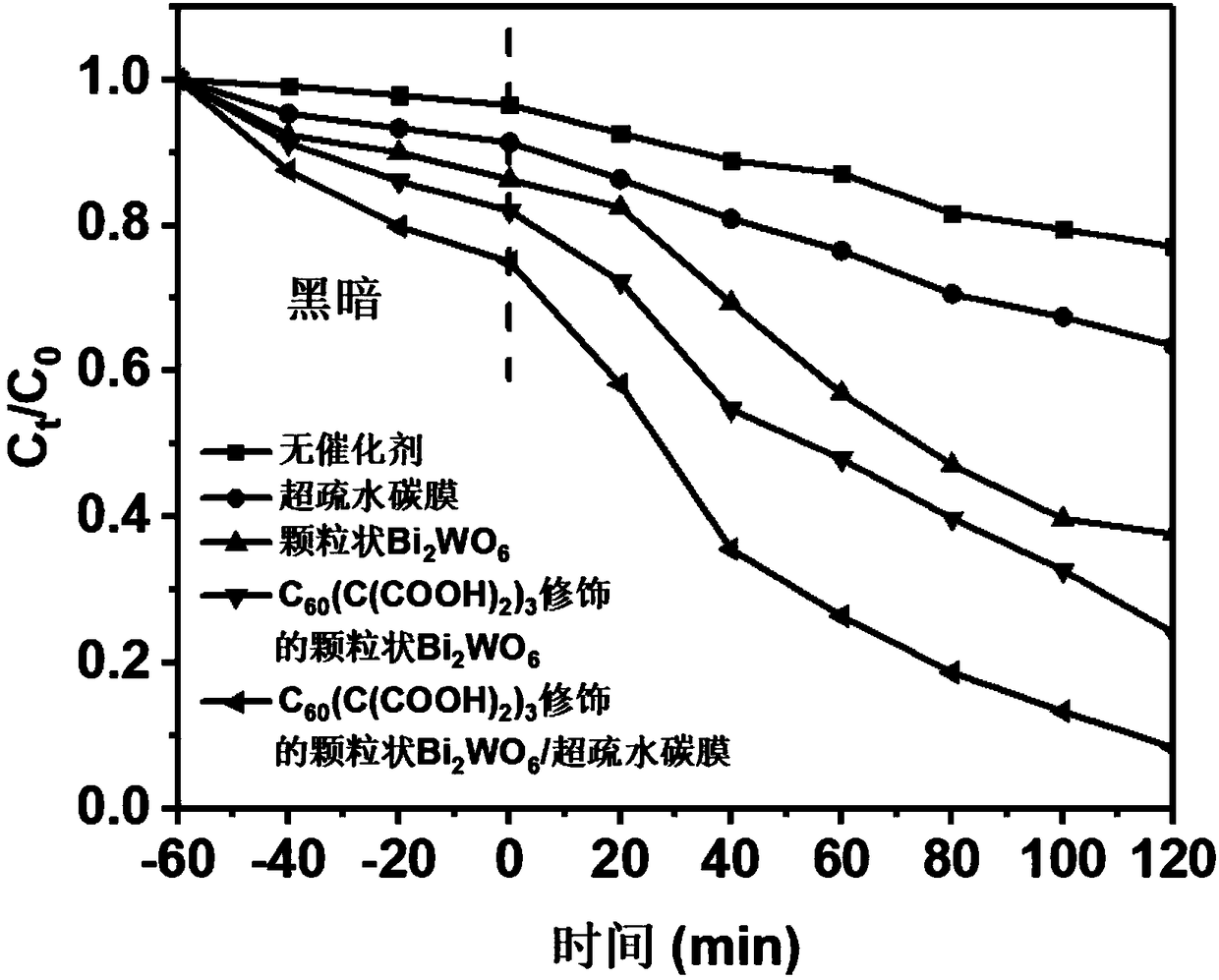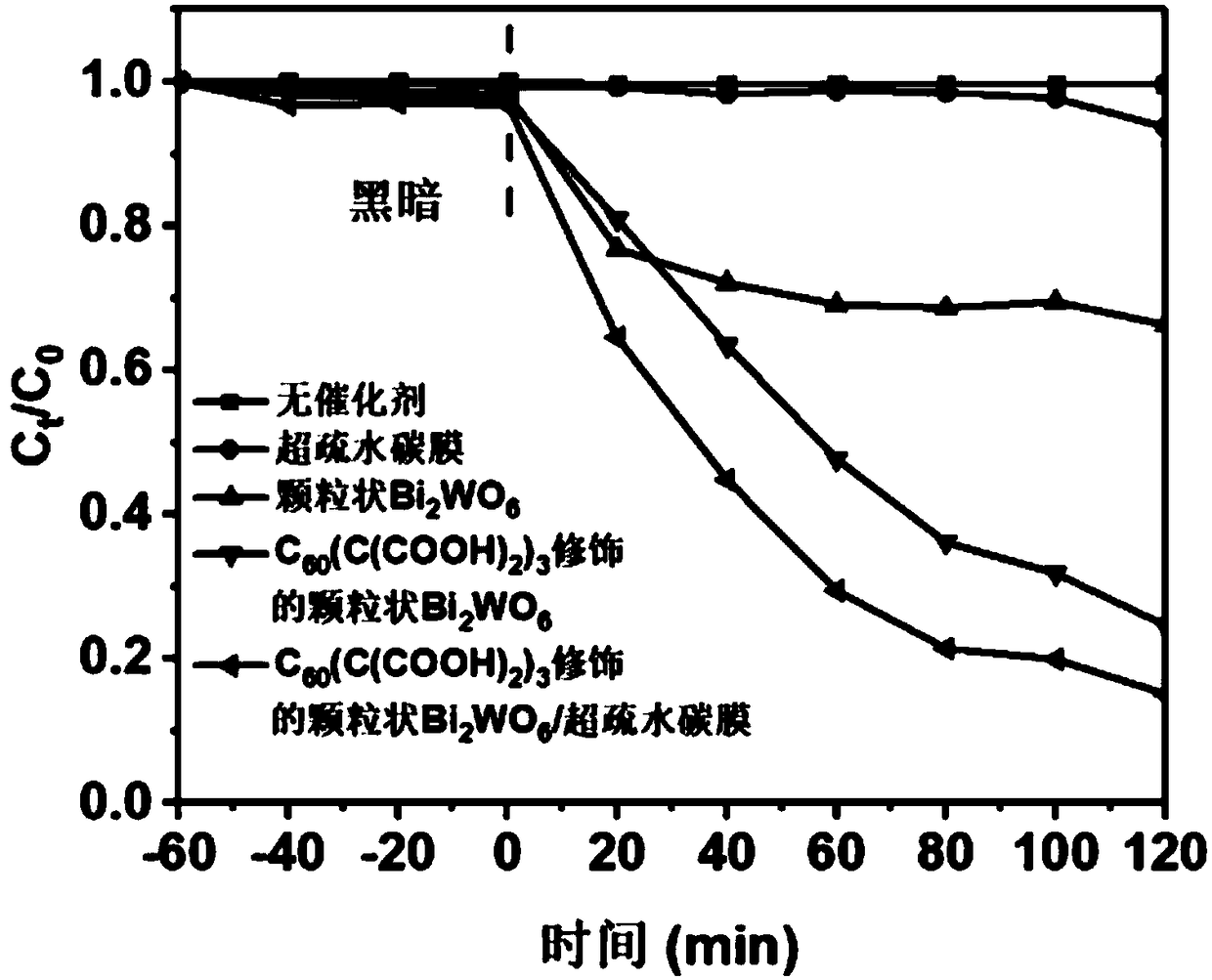Fullerene carboxylic derivative modified photocatalyst/super-hydrophobic membrane composite material
A fullerene carboxyl and photocatalyst technology, applied in the field of photocatalysis, can solve the problems of reducing the probability of electron-hole recombination, speeding up the diffusion of oxygen, increasing the amount of oxygen, etc., to increase the light absorption range, prolong the separation time, The effect of improving conveying efficiency
- Summary
- Abstract
- Description
- Claims
- Application Information
AI Technical Summary
Problems solved by technology
Method used
Image
Examples
Embodiment 1C60
[0058] Example 1C 60 (C(COOH) 2 ) 3 Modified granular Bi 2 WO 6 / superhydrophobic carbon film composite and C 60 (C(COOH) 2 ) 3 Modified flaky Bi 2 WO 6 / Preparation of superhydrophobic carbon film composites
[0059] (1)C 60 (C(COOH) 2 ) 3 Modified granular Bi 2 WO 6 and C 60 (C(COOH) 2 ) 3 Modified flaky Bi 2 WO 6 Preparation of:
[0060] C 60 (C(COOH) 2 ) 3 Modified granular Bi 2 WO 6 Preparation: Add 0.8mmol bismuth nitrate pentahydrate and 0.4mmol sodium tungstate dihydrate to 20ml ethylene glycol to form a homogeneous mixture A, add 0.004mmol C 60 (C(COOH) 2 ) 3 Add to 20ml of ethylene glycol, ultrasonically dissolve to form solution B, then add solution B to the above mixed solution A to form mixed solution C, after stirring for 1 hour, put mixed solution C into a 100ml reaction kettle and keep warm at 160°C 15h, after the reaction, the temperature was lowered to obtain 60 (C(COOH) 2 ) 3 Modified granular Bi 2 WO 6 solution, the solution...
Embodiment 2C60
[0072] Example 2C 60 (C(COOH) 2 ) 3 Modified granular Bi 2 WO 6 / superhydrophobic carbon film composite and C 60 (C(COOH) 2 ) 3 Modified flaky Bi 2 WO 6 / Superhydrophobic carbon film composites are used as photocatalysts
Embodiment 1
[0073] The two composite materials prepared in Example 1 have excellent photocatalytic properties for the degradation of rhodamine B, methyl orange, tetracycline hydrochloride and other organic pollutants, and can achieve more than 90% degradation within 2 hours. The photocatalytic degradation of rhodamine B, methyl orange and tetracycline hydrochloride is shown below in conjunction with the accompanying drawings. 60 (C(COOH) 2 ) 3 Modified granular Bi 2 WO 6 / superhydrophobic carbon film composite and C 60 (C(COOH) 2 ) 3 Modified flaky Bi 2 WO 6 / Effect of superhydrophobic carbon film composites on degradation of organic pollutants.
[0074] The experimental procedure is as follows: take 2.5ml of water samples containing organic pollutants and put them into a cuvette, and the C prepared in Example 1 60 (C(COOH) 2 ) 3 Modified granular Bi 2 WO 6 / Composite material of superhydrophobic carbon film 1 piece or C 60 (C(COOH) 2 ) 3 Modified flaky Bi 2 WO 6 1 she...
PUM
| Property | Measurement | Unit |
|---|---|---|
| wavelength | aaaaa | aaaaa |
Abstract
Description
Claims
Application Information
 Login to View More
Login to View More - R&D
- Intellectual Property
- Life Sciences
- Materials
- Tech Scout
- Unparalleled Data Quality
- Higher Quality Content
- 60% Fewer Hallucinations
Browse by: Latest US Patents, China's latest patents, Technical Efficacy Thesaurus, Application Domain, Technology Topic, Popular Technical Reports.
© 2025 PatSnap. All rights reserved.Legal|Privacy policy|Modern Slavery Act Transparency Statement|Sitemap|About US| Contact US: help@patsnap.com



